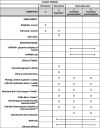Improving the patient-centred care of children with life-altering skin conditions using feedback from electronic patient-reported outcome measures: protocol for a hybrid effectiveness-implementation study (PEDS-ePROM)
- PMID: 33837095
- PMCID: PMC8043009
- DOI: 10.1136/bmjopen-2020-041861
Improving the patient-centred care of children with life-altering skin conditions using feedback from electronic patient-reported outcome measures: protocol for a hybrid effectiveness-implementation study (PEDS-ePROM)
Abstract
Introduction: Using patient-reported outcome measures (PROMs) with children have been described as 'giving a voice to the child'. Few studies have examined the routine use of these measures as potentially therapeutic interventions. This study aims to investigate: (1) the effectiveness of feedback using graphical displays of information from electronic PROMs (ePROMs) that target health-related quality of life, to improve health outcomes, referrals and treatment satisfaction and (2) the implementation of ePROMs and graphical displays by assessing acceptability, sustainability, cost, fidelity and context of the intervention and study processes.
Methods and analysis: A hybrid II effectiveness-implementation study will be conducted from February 2020 with children with life-altering skin conditions attending two outpatient clinics at a specialist paediatric children's hospital. A pragmatic randomised controlled trial and mixed methods process evaluation will be completed. Randomisation will occur at the child participant level. Children or parent proxies completing baseline ePROMs will be randomised to: (1) completion of ePROMs plus graphical displays of ePROM results to treating clinicians in consultations, versus (2) completion of ePROMs without graphical display of ePROM results. The primary outcome of the effectiveness trial will be overall health-related quality of life of children. Secondary outcomes will include other health-related quality of life outcomes (eg, child psychosocial and physical health, parent psychosocial health), referrals and treatment satisfaction. Trial data will be primarily analysed using linear mixed-effects models; and implementation data using inductive thematic analysis of interviews, meeting minutes, observational field notes and study communication mapped to the Consolidated Framework for Implementation Research.
Ethics and dissemination: Ethical approval was obtained from Children's Health Queensland Human Research Ethics Committee (HREC/2019/QCHQ/56290), The University of Queensland (2019002233) and Queensland University of Technology (1900000847). Dissemination will occur through stakeholder groups, scientific meetings and peer-reviewed publications.
Trial registration number: Australian New Zealand Clinical Trials Registry (ACTRN12620000174987).
Keywords: change management; organisation of health services; paediatric dermatology; paediatrics; telemedicine.
© Author(s) (or their employer(s)) 2021. Re-use permitted under CC BY-NC. No commercial re-use. See rights and permissions. Published by BMJ.
Conflict of interest statement
Competing interests: ZT, MS and RMK developed the Brisbane Burn Scar Impact Profile which was included as a scar-specific measure in this study. MS and RMK were clinical staff members of the health service where the study will be conducted at the time of submission.
Figures

Similar articles
-
Optimising symptom management in children with cancer using a novel mobile phone application: protocol for a controlled hybrid effectiveness implementation trial (RESPONSE).BMC Health Serv Res. 2021 Sep 9;21(1):942. doi: 10.1186/s12913-021-06943-x. BMC Health Serv Res. 2021. PMID: 34503489 Free PMC article.
-
Patient Reported Outcome Measures in cancer care: a hybrid effectiveness-Implementation trial to optimise Symptom control and health service Experience (PROMISE)-protocol for a randomised controlled trial of electronic self-reporting of symptoms versus usual care during and following treatment in patients with cancer.BMJ Open. 2024 Nov 19;14(11):e090836. doi: 10.1136/bmjopen-2024-090836. BMJ Open. 2024. PMID: 39566946 Free PMC article.
-
Embedding electronic patient-reported outcome measures into routine care for patients with stage III MELanoma (ePROMs-MEL): protocol for a prospective, longitudinal, mixed-methods pilot study.BMJ Open. 2022 Dec 20;12(12):e066852. doi: 10.1136/bmjopen-2022-066852. BMJ Open. 2022. PMID: 36600423 Free PMC article.
-
Assessing Patient-Reported Outcomes in Routine Cancer Clinical Care Using Electronic Administration and Telehealth Technologies: Realist Synthesis of Potential Mechanisms for Improving Health Outcomes.J Med Internet Res. 2023 Nov 28;25:e48483. doi: 10.2196/48483. J Med Internet Res. 2023. PMID: 38015606 Free PMC article. Review.
-
Improving the Understanding and Managing of the Quality of Life of Patients With Lung Cancer With Electronic Patient-Reported Outcome Measures: Scoping Review.J Med Internet Res. 2023 May 3;25:e46259. doi: 10.2196/46259. J Med Internet Res. 2023. PMID: 37021695 Free PMC article.
Cited by
-
Barriers and facilitators of electronic patient-reported outcome measures (e-PROMs) for patients in home palliative cancer care: a qualitative study of healthcare professionals' perceptions.BMC Palliat Care. 2023 Aug 4;22(1):111. doi: 10.1186/s12904-023-01234-0. BMC Palliat Care. 2023. PMID: 37542264 Free PMC article.
-
Usability of an Automated System for Real-Time Monitoring of Shared Decision-Making for Surgery: Mixed Methods Evaluation.JMIR Hum Factors. 2024 Apr 10;11:e46698. doi: 10.2196/46698. JMIR Hum Factors. 2024. PMID: 38598276 Free PMC article.
-
Validation and Acceptability of the Mobile App Version of the Control of Allergic Rhinitis and Asthma Test for Children (CARATKids): Cross-Sectional Study.JMIR Pediatr Parent. 2025 Jul 31;8:e73531. doi: 10.2196/73531. JMIR Pediatr Parent. 2025. PMID: 40743508 Free PMC article.
-
Optimising symptom management in children with cancer using a novel mobile phone application: protocol for a controlled hybrid effectiveness implementation trial (RESPONSE).BMC Health Serv Res. 2021 Sep 9;21(1):942. doi: 10.1186/s12913-021-06943-x. BMC Health Serv Res. 2021. PMID: 34503489 Free PMC article.
-
User-Centered Design and Usability of Voxe as a Pediatric Electronic Patient-Reported Outcome Measure Platform: Mixed Methods Evaluation Study.JMIR Hum Factors. 2024 Sep 19;11:e57984. doi: 10.2196/57984. JMIR Hum Factors. 2024. PMID: 39298749 Free PMC article.
References
Publication types
MeSH terms
LinkOut - more resources
Full Text Sources
Other Literature Sources
